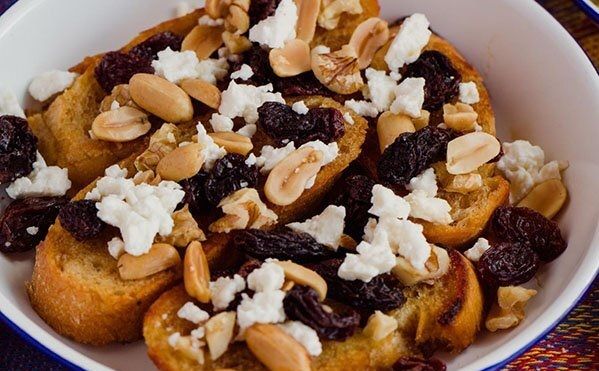This delicious appetizer of Mexican cuisine is called capirotada, plus two recipes on how to prepare it
Capirotada prevents waste and constitutes a delicious appetizer of Mexican cuisine. Here's what it is, including two recipes on how to prepare it.

As it is made with aged ingredients, capirotada prevents waste and constitutes a delicious appetizer of Mexican cuisine. Because it is an important source of carbohydrates, it is recommended to be consumed in small portions with a drink such as coffee or unsweetened tea, or with unflavored milk for children, which can be served hot or cold.
Its name derives from "capirote", referring to the hats worn by some priests during Holy Week. The capirotada is a traditional Mexican dessert made of stale bread, piloncillo, cinnamon, peanuts, and cheese, with a touch of cloves, whose recipe was first recorded in the book De re coquinaria, by the Roman Apicius, dating from the fourth century and where he described the recipe of La Sala Cattabia, a predecessor preparation to the dish we know today.
In this book, its preparation was quite different, since it was made with vinegar, cucumbers, wine pips, capers, and chicken liver. What the capirotada kept was the layered bread and the homogenization of the ingredients. Later the recipe was written under the name of "Sopa de Capirotada" in a book by Francisco Martínez Montiño in 1611, who introduced grated cheese between the layers of bread.
It was not until the arrival of the Spaniards to Mexico that the capirotada was transformed into a meatless dish and in 1780 it was described in cookbooks as a vigil dish that contained as main ingredients the layers of bread, cheese, piloncillo-based seasoning, and tomato. It is believed that the elimination of meat from the original recipe was due to a food crisis in the second half of the 18th century and the 1960s the preparation of the capirotada recipe, currently popular in Mexico, was resumed.
The states where capirotada is a particular dessert are Colima, Chihuahua, Coahuila, Durango, Nayarit, Sinaloa, Sonora, Zacatecas, Tamaulipas, Baja California Sur, Jalisco, Michoacán, San Luis, Potosí, Guanajuato and Nuevo León, where it is mainly consumed during Lent. Its preparation changes depending on where it is prepared and can vary the content of tomato, onion, nuts, ground chickpeas, milk, cloves, cinnamon and almonds.
What nutrients and benefits does it provide?
The main ingredients of capirotada are mostly healthy foods. Here we explain their nutritional characteristics and health benefits. Cinnamon is rich in calcium, manganese, fiber, and antioxidants. It helps to build strong bones and fight free radicals, reducing the risk of heart disease or some types of cancer, as well as strengthening our immune system and delaying the aging process.
Raisins contain a large number of antioxidants such as resveratrol and zeaxanthin, which have a protective cardiovascular effect. Because of its fiber content, it is also a good prebiotic that helps maintain healthy intestinal microbiota. It is also a source of calcium, potassium, and iron. Peanuts are an important source of vegetable fats, mostly monounsaturated, which promote cardiovascular health. They are also a source of protein.
Cotija cheese, although it is a high-fat food, which is why its consumption should be moderate, is a very good source of vitamin A, calcium, and protein. The tomato is rich in vitamin C and potassium, its red color is a result of its high content of beta-carotene, a form of vitamin A. It also contains lycopene, a linoleic acid. In addition, it contains lycopene, lutein, and zeaxanthin, powerful antioxidants.
Flavonoids and phytosterols are also present in tomatoes as phytochemicals, which in addition to being antioxidants can act as anti-inflammatories and antivirals. All these nutrients provide direct health benefits to the digestive, cardiovascular and immune systems, among many other vital functions.
Clove is a source of eugenol and flavonoids, which have various properties such as anti-inflammatory, combat digestion, and stimulate good circulation. Onion contains vitamins A, B6, C, and E, folic acid and is also a good source of potassium, iron, and fiber.
How is it recommended to consume it?
As it is made with aged ingredients, capirotada prevents waste and constitutes a delicious appetizer of Mexican cuisine. As it is an important source of carbohydrates, it is recommended to consume it in small portions with a drink such as coffee or unsweetened tea, or with unflavored milk for children, which can be served hot or cold.
It is important to consider adding as little sugar as possible in its preparation, in this case, piloncillo, so that it retains its characteristic sweet flavor, but without excess. An ideal time to consume capirotada is after physical activity since it is rich in energy and helps the body to recover and restore muscle cells.
Prepare and enjoy a capirotada during these Lenten celebrations and share it with your family. Here are some recipes on how to prepare it.
Capirotada with tomato and onion recipe
Ingredients:
6 to 8 bolillos cut in slices
2 piloncillo cones
1 tomato
1 small piece of onion
1 cinnamon stick
1 tomato
1 small piece of onion
1 clove
1 coarse pepper
Dried cheese
Nuts to taste
Raisins to taste
Tortillas
1 liter of water
Preparation:
Brown the bolillo slices on both sides. In a pot add 1 liter of water, the piloncillo, cinnamon, tomato, onion, pepper, and cloves until the piloncillo has completely disintegrated. Place a pan over low heat with the tortillas covering the bottom. Dip each slice of golden bread in the piloncillo syrup and arrange them in layers.
When the first layer of bread is finished, add cheese, raisins, and nuts to taste. Repeat this until the bread is finished. If there is syrup remaining, drizzle it on top of the bread, cover the pan and let it cook for 5 minutes and ready, enjoy this delicious capirotada. The tortillas are so that the bread does not stick to the pan.
Capirotada morena recipe
Ingredients:
16 slices of stale bolillo bread or birote (at least 2 days old)
2 tablespoons of light butter in cubes
¾ cup piloncillo
1½ cup water
1 cinnamon stick
2 cloves
¼ cup raisins
2 tablespoons of melted butter
¾ cup Cotija cheese
5 tablespoons vegetable oil
¼ cup peanuts
3 cups water
Preparation:
Preheat oven to 180°C. In a medium saucepan, heat the piloncillo, cinnamon, cloves, and water over medium heat until the piloncillo melts and forms a syrup. Mix the butter -previously melted- with the oil and coat the bread slices with this mixture. Place the bread slices on a baking sheet and bake them in the oven for 8 minutes. Then, turn the bread slices over so that they are evenly browned and leave them in the oven for about 5 more minutes until they are light golden brown.
Place the bread slices in the base of a baking pan and cover each slice with the piloncillo syrup. (Make sure each slice is well soaked in the syrup.) If you prefer, soak the bread in the syrup first and then place it in the pan.
Top this first layer of bread with cheese, raisins, peanuts, and any other fruit or nuts you have decided to add. Place another layer of bread and continue with the same process as in the previous step. When you have finished with all the layers, add the rest of the syrup; top with cheese, raisins, and peanuts, and place the butter cubes on top.
Cover the pan with aluminum foil and bake for approximately 45 minutes until all the layers of bread are moistened and a golden layer has formed. The capirotada can be served hot or cold.
Source: Elpoderdelconsumidor.org




